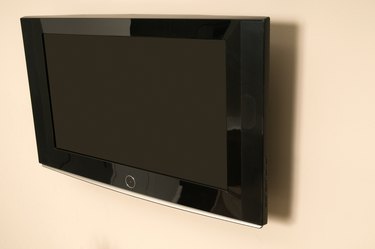
Part of the appeal of flat panel TVs mounted to a wall is the ability to conceal wiring. Electrical and television signal wires pass through the walls to junction boxes, concealed behind the mounting bracket. Placing these boxes correctly is integral to ensuring the television fits firmly against the wall with the least amount of visible wiring.
Outlet Types
Video of the Day
AC power wires or Romex are required to properly wire flat panel television sets. You will need a set of audio/video cables routed behind the TV set as well. Several modern home theater installations only require a single High Definition Multimedia Interface cable routed from the audio/video receiver's location, since these receivers switch all the audio and video signals. Optionally, an Ethernet cable can be run with the HDMI cable for those flat panels possessing Internet functionality. For both AC and low voltage cabling, you will need a junction box. Both are positioned in a way that they are perfectly concealed by the television. Most brackets have two square-shaped cutouts, with one side devoted to AC power while the other is for the signal cables.
Video of the Day
Placement Considerations
The height of the outlets is directly related to the mounting location of the television's wall mount bracket. Plasma flat panels have more consistent picture quality as you view the set from the side. Liquid crystal displays experience blacks that turn gray, and colors that shift to different tones. Remember that this happens vertically as well as horizontally, so for theater or media room viewing, place the television as close to your normal line of sight when seated. Placing a set at or close to eye level also reduces neck strain and eye fatigue during extended viewing.
Installation Process
An outlet-sized hole is cut at the height of the outlet toward the base of the wall, normally one foot from the floor. Through this hole passes any signal cables leading from the equipment rack to the back of the TV. Both junction boxes are terminated with nose plates that conceal the junction box while allowing the cables to pop out unimpeded. Decide where you want the set first, which dictates the bracket location. Mark the bracket's location, aligned with two vertical studs in the wall.
Code Compliance
For the AC wire, you are required by code to have a metal junction box installed. To ensure code compliance, have an electrician run the AC wire directly from the service panel in the basement or a lower level of the home to the new outlet's location. Alternately, install a kit that jumps one nearby outlet to service the new outlet located behind the television. These kits come with new outlets, extension cords and Romex to complete the installation process. Plastic or metal junction boxes are acceptable for low-voltage signal cables. It is against code to pass an extension cord or the power cord supplied with the television directly through the wall. Only shielded or unshielded Romex is code-compliant for in-wall use.